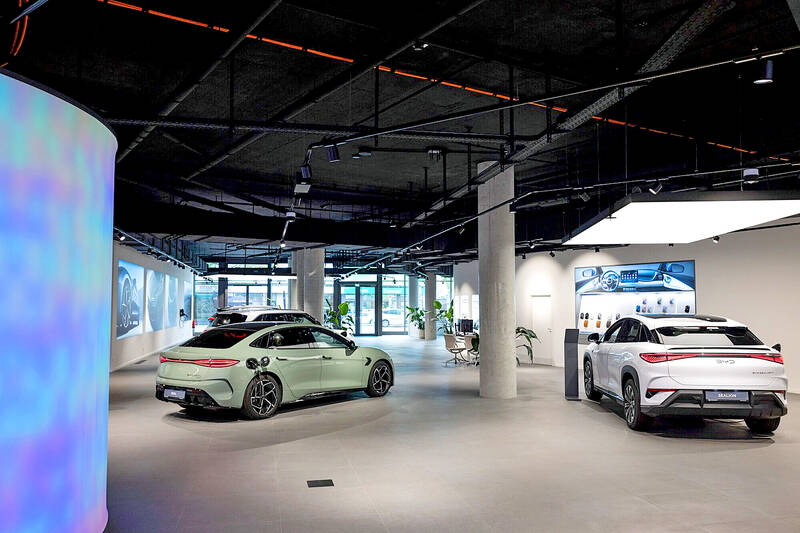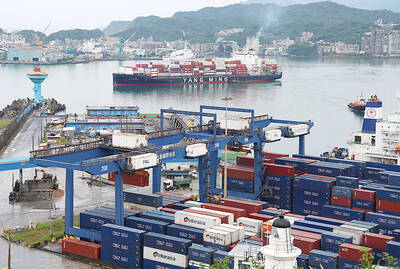Checking out an electric vehicle (EV) made by China’s BYD at the IAA Mobility car show in Munich, Germany, German designer Tayo Osobu was impressed by the interior and said she would consider buying one.
“And why not?” asked the 59-year-old from Frankfurt, Germany, in a country where domestic titans Volkswagen, BMW and Mercedes-Benz have long dominated.
“If they are sold here, it means they meet European standards,” she said.

Photo: Bloomberg
At the auto fair last week, Chinese EV makers were out in force, highlighting the determination of the country’s fast-growing car giants to make inroads into Europe.
About 100 Chinese auto companies flocked to Munich, out of a total 700 exhibitors at the show hosted once every two years, ranging from big-name manufacturers to smaller suppliers and start-ups.
While they still lag far behind Europe’s long-established carmakers in terms of market share on the continent, firms from the world’s No. 2 economy have been gaining ground with their technology-packed EVs.

Photo: Bloomberg
Leading the pack is giant BYD, whose sales in Europe surged by 250 percent in the first half of the year. In Munich, the manufacturer was showcasing flagship models such as the Dolphin Surf, a small EV with a starting price of about 20,000 euros (US$23,463) — cheaper than many offerings from European carmakers.
Volkswagen, Europe’s biggest automaker, in contrast has seen sales and profits fall in the face of fierce competition and weak demand, prompting it to announce plans for mass layoffs in Germany. US EV pioneer Tesla, which was not present at the show in Munich, has also seen its market share drop — in part because many consumers have been put off by its boss Elon Musk’s support for far-right political parties.
Chinese carmakers have grown rapidly as they have benefited from lower labor costs, generous government support and strong consumer demand for their high-tech models in the world’s biggest auto market, experts said.
“What has changed in five years is that, at a lower price, the Chinese are now on par in terms of technology and quality in many respects,” said Stefan Bratzel, director of the Center of Automotive Management in Germany.
To combat the influx of Chinese cars and protect European manufacturers, the EU last year slapped hefty new tariffs on Chinese-made EVs over what the bloc said were unfair state subsidies.
However, sales of Chinese electric cars have continued to grow, and BYD looks set to skirt the levies — its first European factory, in Hungary, would start production later this year.
However, Bratzel said it was “too early” to talk about an invasion.
Chinese carmakers still need to establish “a relationship of trust” with European consumers, and build up networks of dealerships and after-sales services, he said.
There was skepticism about Chinese cars among some of those attending the Munich fair.
“If you drive a Chinese car, which garage would you go to if there are problems?” said Pamina Lohrmann, a 22-year-old German woman, at the Volkswagen stand where an old model of the popular Polo was on display.
“I grew up with German brands, they appeal to me more,” Lohrmann said.
Despite such concerns, some Chinese carmakers, such as Xpeng, are hoping to attract a tech-savvy, younger demographic.
XPeng president Brian Gu said the manufacturer was aiming for “the first wave of tech enthusiasts.”
Europe’s storied carmakers are fighting back, hoping their trustworthy reputations, built over many decades, would stand them in good stead.
Among a series of more affordable EVs unveiled by Volkswagen in Munich last week was one named “ID.Polo,” aiming to capitalize on the popularity of its classic small car.
European carmakers are also adopting new battery technology and looking at using more Chinese components in their vehicles, industry expert Matthias Schmidt said.
They aim to focus on their “heritage, legacy and DNA,” Schmidt said, adding that these are characteristics that “Chinese new market entrants simply don’t have.”

CHIP RACE: Three years of overbroad export controls drove foreign competitors to pursue their own AI chips, and ‘cost US taxpayers billions of dollars,’ Nvidia said China has figured out the US strategy for allowing it to buy Nvidia Corp’s H200s and is rejecting the artificial intelligence (AI) chip in favor of domestically developed semiconductors, White House AI adviser David Sacks said, citing news reports. US President Donald Trump on Monday said that he would allow shipments of Nvidia’s H200 chips to China, part of an administration effort backed by Sacks to challenge Chinese tech champions such as Huawei Technologies Co (華為) by bringing US competition to their home market. On Friday, Sacks signaled that he was uncertain about whether that approach would work. “They’re rejecting our chips,” Sacks

Taiwan’s exports soared 56 percent year-on-year to an all-time high of US$64.05 billion last month, propelled by surging global demand for artificial intelligence (AI), high-performance computing and cloud service infrastructure, the Ministry of Finance said yesterday. Department of Statistics Director-General Beatrice Tsai (蔡美娜) called the figure an unexpected upside surprise, citing a wave of technology orders from overseas customers alongside the usual year-end shopping season for technology products. Growth is likely to remain strong this month, she said, projecting a 40 percent to 45 percent expansion on an annual basis. The outperformance could prompt the Directorate-General of Budget, Accounting and

NATIONAL SECURITY: Intel’s testing of ACM tools despite US government control ‘highlights egregious gaps in US technology protection policies,’ a former official said Chipmaker Intel Corp has tested chipmaking tools this year from a toolmaker with deep roots in China and two overseas units that were targeted by US sanctions, according to two sources with direct knowledge of the matter. Intel, which fended off calls for its CEO’s resignation from US President Donald Trump in August over his alleged ties to China, got the tools from ACM Research Inc, a Fremont, California-based producer of chipmaking equipment. Two of ACM’s units, based in Shanghai and South Korea, were among a number of firms barred last year from receiving US technology over claims they have

BARRIERS: Gudeng’s chairman said it was unlikely that the US could replicate Taiwan’s science parks in Arizona, given its strict immigration policies and cultural differences Gudeng Precision Industrial Co (家登), which supplies wafer pods to the world’s major semiconductor firms, yesterday said it is in no rush to set up production in the US due to high costs. The company supplies its customers through a warehouse in Arizona jointly operated by TSS Holdings Ltd (德鑫控股), a joint holding of Gudeng and 17 Taiwanese firms in the semiconductor supply chain, including specialty plastic compounds producer Nytex Composites Co (耐特) and automated material handling system supplier Symtek Automation Asia Co (迅得). While the company has long been exploring the feasibility of setting up production in the US to address